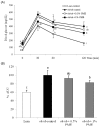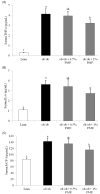Hog millet (Panicum miliaceum L.)-supplemented diet ameliorates hyperlipidemia and hepatic lipid accumulation in C57BL/6J-ob/ob mice
- PMID: 22259675
- PMCID: PMC3259293
- DOI: 10.4162/nrp.2011.5.6.511
Hog millet (Panicum miliaceum L.)-supplemented diet ameliorates hyperlipidemia and hepatic lipid accumulation in C57BL/6J-ob/ob mice
Abstract
Dietary intake of whole grains reduces the incidence of chronic diseases such as obesity, diabetes, cardiovascular disease, and cancer. In an earlier study, we showed that Panicum miliaceum L. extract (PME) exhibited the highest anti-lipogenic activity in 3T3-L1 cells among extracts of nine different cereal grains tested. In this study, we hypothesized that PME in the diet would lead to weight loss and augmentation of hyperlipidemia by regulating fatty acid metabolism. PME was fed to ob/ob mice at 0%, 0.5%, or 1% (w/w) for 4 weeks. After the experimental period, body weight changes, blood serum and lipid profiles, hepatic fatty acid metabolism-related gene expression, and white adipose tissue (WAT) fatty acid composition were determined. We found that the 1% PME diet, but not the 0.5%, effectively decreased body weight, liver weight, and blood triglyceride and total cholesterol levels (P < 0.05) compared to obese ob/ob mice on a normal diet. Hepatic lipogenic-related gene (PPARα, L-FABP, FAS, and SCD1) expression decreased, whereas lipolysis-related gene (CPT1) expression increased in animals fed the 1% PME diet (P < 0.05). Long chain fatty acid content and the ratio of C18:1/C18:0 fatty acids decreased significantly in adipose tissue of animals fed the 1% PME diet (P < 0.05). Serum inflammatory mediators also decreased significantly in animals fed the 1% PME diet compared to those of the ob/ob control group (P < 0.05). These results suggest that PME is useful in the chemoprevention or treatment of obesity and obesity-related disorders.
Keywords: C57BL/6J-ob/ob; Panicum miliaceum L. extract; fatty acid; hyperlipidemia.
Figures





Similar articles
-
Carnosic acid attenuates obesity-induced glucose intolerance and hepatic fat accumulation by modulating genes of lipid metabolism in C57BL/6J-ob/ob mice.J Sci Food Agric. 2015 Mar 15;95(4):828-35. doi: 10.1002/jsfa.6973. Epub 2014 Nov 24. J Sci Food Agric. 2015. PMID: 25348739
-
Defatted safflower seed extract inhibits adipogenesis in 3T3-L1 preadipocytes and improves lipid profiles in C57BL/6J ob/ob mice fed a high-fat diet.Nutr Res. 2016 Sep;36(9):995-1003. doi: 10.1016/j.nutres.2016.07.004. Epub 2016 Jul 25. Nutr Res. 2016. PMID: 27632920
-
Methionine restriction prevents the progression of hepatic steatosis in leptin-deficient obese mice.Metabolism. 2013 Nov;62(11):1651-61. doi: 10.1016/j.metabol.2013.06.012. Epub 2013 Aug 5. Metabolism. 2013. PMID: 23928105
-
Korean Chungtaejeon tea extract attenuates body weight gain in C57BL/6J-Lep ob/ob mice and regulates adipogenesis and lipolysis in 3T3-L1 adipocytes.J Integr Med. 2017 Jan;15(1):56-63. doi: 10.1016/S2095-4964(17)60321-2. J Integr Med. 2017. PMID: 28088260
-
Regulation of obesity and lipid disorders by herbal extracts from Morus alba, Melissa officinalis, and Artemisia capillaris in high-fat diet-induced obese mice.J Ethnopharmacol. 2008 Jan 17;115(2):263-70. doi: 10.1016/j.jep.2007.09.029. Epub 2007 Oct 5. J Ethnopharmacol. 2008. PMID: 18023310
Cited by
-
Effects of the Complex of Panicum miliaceum Extract and Triticum aestivum Extract on Hair Condition.Nutrients. 2023 Oct 18;15(20):4411. doi: 10.3390/nu15204411. Nutrients. 2023. PMID: 37892488 Free PMC article.
-
Exogenous hydrogen sulfide mitigates the fatty liver in obese mice through improving lipid metabolism and antioxidant potential.Med Gas Res. 2015 Jan 10;5(1):1. doi: 10.1186/s13618-014-0022-y. eCollection 2015. Med Gas Res. 2015. PMID: 25606341 Free PMC article.
-
Can Millets Mitigate Diabetes?Indian J Endocrinol Metab. 2024 Nov-Dec;28(6):551-553. doi: 10.4103/ijem.ijem_514_24. Epub 2024 Dec 30. Indian J Endocrinol Metab. 2024. PMID: 39881768 Free PMC article. No abstract available.
-
Sorghum extract exerts an anti-diabetic effect by improving insulin sensitivity via PPAR-γ in mice fed a high-fat diet.Nutr Res Pract. 2012 Aug;6(4):322-7. doi: 10.4162/nrp.2012.6.4.322. Epub 2012 Aug 31. Nutr Res Pract. 2012. PMID: 22977686 Free PMC article.
References
-
- Kantartzis K, Schick F, Häring HU, Stefan N. Environmental and genetic determinants of fatty liver in humans. Dig Dis. 2010;28:169–178. - PubMed
-
- Ntambi JM, Miyazaki M, Dobrzyn A. Regulation of stearoyl-CoA desaturase expression. Lipids. 2004;39:1061–1065. - PubMed
-
- Sjögren P, Sierra-Johnson J, Gertow K, Rosell M, Vessby B, de Faire U, Hamsten A, Hellenius ML, Fisher RM. Fatty acid desaturases in human adipose tissue: relationships between gene expression, desaturation indexes and insulin resistance. Diabetologia. 2008;51:328–335. - PubMed
LinkOut - more resources
Full Text Sources
Research Materials
Miscellaneous

